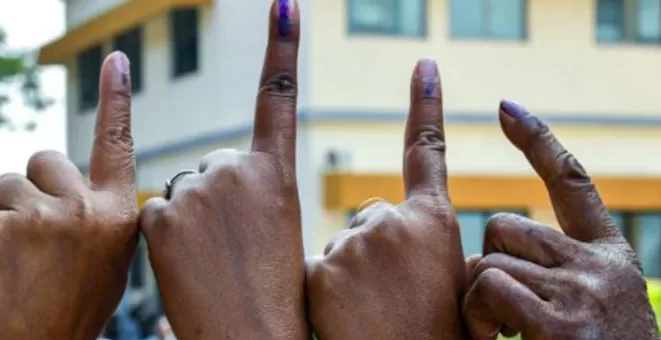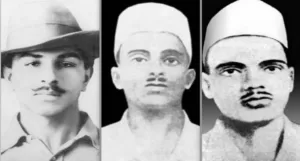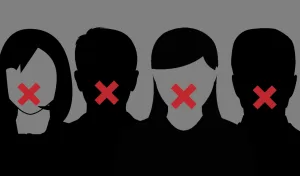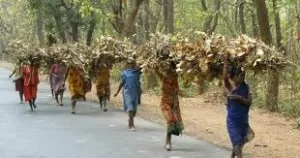‘One Nation One Election’ Neither Saves Money Nor Improves GDP – It Only Impairs Federalism
P. Raman
Spin dictators of the 21st century have invented ingenious methods to establish themselves in power. Tyyip Erdogan of Turkey in 2018 imposed a presidential system of government with more powers concentrating on him.
Narendra Modi, however, chose the more unobtrusive route of simultaneous elections to the Lok Sabha and state assemblies. A committee was appointed with former President Ram Nath Kovind as chairman to recommend the constitutional amendments needed to implement the proposal. It submitted the report in March well before the elections.
This was at a time when the Modi government was dreaming of winning ‘400 paar’ seats in the 18th general election in India – almost three-fourths and much more than two-thirds needed for necessary constitutional amendments for introducing simultaneous elections. Such a decisive victory, had it happened, could have made Modi an unassailable prime minister.
The ruling establishment was sure that the resultant political momentum might trigger deep fissures in opposition ranks and thus, help the National Democratic Alliance (NDA) get the constitutional approval of the majority of states. With such an overawing legislative support, Modi-Shah could have gained absolute powers – more than what Tayyip Erdogan’s presidential system had.
Look at the way the BJP brass, in the aftermath of the 2019 victory, bulldozed legislative business, like the Jammu and Kashmir bill for bifurcation of the state and abolition of Article 370. Even the Union cabinet was told of the bills barely 90 minutes before it was presented in the parliament on August 5, 2019. Only four people knew of the bills – not even Rajnath Singh.
Janata Dal (United) leader K.C. Tyagi admitted to the BBC that none of the NDA allies were aware of the bills. It was not included in that day’s agenda. Instead, the House was told to take it up as a special case and passed the same day.
Prior to that, there was also a massive midnight swoop of opposition leaders in Jammu and Kashmir, some of whom were put under house arrest.
A hundred companies of paramilitary troops were deployed in Kashmir and 38,000 kept ready at crucial points in what jurist A.G. Noorani called an operation ‘conceived in malice and executed in deceit’. And the Rashtrapati Bhawan gave assent to the bills within 72 hours of passage in the parliament.
Think of the ominous portents this entails. If Modi-Shah, with the support of 303 MPs in Lok Sabha could take to such political adventures as ‘Operation Kashmir’ with utmost secrecy and precision, NDA with ‘400 paar’ might have effortlessly superimposed dictatorial order without declaring formal dictatorship.
Under this scenario, such an all-powerful regime could restore the national judicial appointments commission by legislation and thus, remove the only stumbling block in its way. It could also reverse the Supreme Court restrictions on enforcement agencies.
Despite the electoral setback, one may wonder what made the Modi-Shah duo press ahead with the Kovind panel report. The advantages of this authoritarian project, however, far outweigh the risks.
Firstly, by converting the five-yearly elections into a single-strike contest, the Modi government could make the best use of its superior resources amassed over the years. It could turn the election more presidential and Modi-centric.
These are the areas where he could overshadow the Congress and regional parties and make it a straight ‘Modi vs. the rest’ contest. His ability for massive mobilisation and brute control over media will render the fight highly unequal. This will give him the ability to set his own agenda and force the rivals to respond to it.
Who can match the massive publicity blitzkrieg with electronic, print media and outdoor advertisements with imposing Modi portraits staring at you everywhere? Which party can match the BJP with its endless funding? Then there are Modi films and biopics hailing the hero and heaping scorn on others. Elections after a gap of five years will make the strike more effective and well targeted.
Second is the conflict of cult creation and frequent elections. Modi has been the worst victim of election fatigue. In BJP, votes are sought in his name. During every election – state assembly or Lok Sabha – he must address the maximum number of rallies and hold road shows. This is a big strain on the 74-year old leader.
But this cannot be avoided because cult promotion is also an essential part of the strong leader build-up. That is how the five-yearly elections held simultaneously to Lok Sabha and state assemblies will be a great relief for Modi and Shah.
The Kovind panel also has a concealed safety valve for the Prime Minister. Going by former finance minister P. Chidambaram’s interpretation, if the Lok Sabha is dissolved a month after the election of a state assembly, the latter would be forced to have another election to align with that of Parliament.
This will create an anomalous situation wherein opposition chief ministers and their MLAs will pressurise their leaders not to bring down the Union government. Otherwise, they would also be forced to undergo another election months after the earlier one. Thus, the Union leaders will be forced to take it to the brink in Parliament.
There is another highly pernicious consequence of the simultaneous elections. When a state government falls, say after two years, the MLAs will strive hard to avert the dissolution and loss of position for the rest of three years. The result – mass defections and horse-trading.
The fund-rich BJP, with a record of mass defections and toppling governments, will apparently be the gainer. The tenth schedule, which governs defections, has already been proved ineffective to check horse trading. Thus, the collapse of governments in states will be a golden opportunity for political operators to capture new states.
Is the present practice of separate elections as bad as the Kovind panel wants us to believe?
A functioning democracy is much more than holding elections every five years and wresting majority in legislatures. It has to be truly representative. Periodic elections without outside interference and with citizen participation are the essence of deliberative democracy.
Merging all elections – the Lok Sabha, state assemblies and over 250,000 village panchayats – together under a combined campaign every five years reduces democracy into a referendum over the PM. Or a tie between Modi and the rest. It invariably imposes another layer of centralisation. It undermines federalism and equates the interests of individual states with that of the prime minister.
Every state, every panchayat has its own local problems which should be debated and voted on. These should not get overshadowed by a Modi vs. Rahul (or Mamata) question. The present system of standalone elections keeps the rulers on their toes and holds them responsive to public demands.
Under the proposed One Nation One Election (ONOE), rulers could make false promises during the month-long din and bustle and get away with them for the next five years.
Does the argument that ‘perpetual’ elections ‘throughout’ the year impeded government decisions and affected GDP growth fit, as claimed by the protagonists of ONOE? A closer look will reveal that this is due to a misleading interpretation of the model code of conduct.
When assembly elections are held for a few states, the MCC is confined to those states. The rest of the country could move ahead with government programmes.
In fact, more disruption will happen when the assembly is prematurely dissolved to make its term ‘simultaneous’ with that of the Lok Sabha. This will awfully erode the diversity, autonomy and plurality of the states, as well as the federal rights that the constitution ensures to the states.
Another argument in defence of simultaneous elections has been that it is ‘financially efficient’, though the Kovind panel report does not reveal any details of the savings to the government.
To begin with, democracy cannot be measured in terms of costs. Moreover, during the five years from 2019, the Union government spent just 0.09% of its total expenditure of Rs 37.35 lakh crore on elections – far less than what it spends on many of the 80 odd PM schemes.
The fear of ‘perpetual’ elections is largely caused by the centralisation of the election by the national parties, chiefly, the BJP. The main ruling party at the Union will strive hard to obliterate the regional parties, who will be left to respond to Modi’s denunciations and accusations.
The proposal for simultaneous elections to the Lok Sabha and state assemblies was first mooted by the Election Commission in 1982. However, the Congress government – so sure of Indira Gandhi’s grip over the voters – disfavoured the idea, as mentioned in Chapter X of the ECI annual report, 1983.
Against this, both BJP prime ministers – Atal Bihari Vajpayee and Narendra Modi – have strived hard to change the existing constitutional system in order to take advantage of their presumed popularity and establish themselves in power. The Vajpayee government had set up a commission in 2000 headed by M. Venkatasubbaiah to review the working of the Constitution.
It was in this background that home minister L.K. Advani pushed for a presidential system of government. This had evoked strong criticism by then President K.R. Narayanan.
The Venkatasubbaiah panel submitted its report too but the idea was finally dropped following criticism by the opposition.
(P. Raman is a veteran journalist. Courtesy: The Wire.)
❈ ❈ ❈
Will ‘One Election One Nation’ Really Prevent Policy Paralysis?
M. Sridhar Acharyulu
The ruling National Democratic Alliance (NDA) has been promoting the scheme of ‘One Nation One Election’ (ONOE), also called a simultaneous poll plan. This so-called scheme does not include polls for the local bodies.
‘One Nation One Election’ is impossible, because the whole nation has to go to polls for local bodies, but at different times, or it may be postponed indefinitely. This means there will be two elections all over the nation.
ONOE is a big task with high risk to federal India. The Prime Minister has said that frequent polls required updating voter lists and involved many tasks, often affecting teachers’ duties besides creating governance difficulties.
The nation cannot ignore the political repercussions, as far as consequences go, which will cause both a constitutional and political problem.
The government explained the concept of ‘One Nation One Election’ and referred to countries like the U.S., where the date for forming a new government was fixed and elections were held every four years.
President Droupadi Murmu said that simultaneous polls “will prevent policy paralysis”. She explained that the proposal to synchronise election schedules in the country is a reform measure that promises to “redefine” the terms of good governance.
She said that the ONOE plan can promote consistency in governance, mitigate resource diversion, and reduce the financial burden, apart from offering many other benefits. Essentially, she said, it is to conduct elections to the Lok Sabha and state legislative assemblies of all 28 states and 8 union territories simultaneously.
The Bill was introduced in Lok Sabha on December 17, 2024, while a division vote was followed, where 269 members supported the move and 198 opposed it.
Scheme or scam?
The Union government called ONOE a “scheme” initially but later it was criticised as a scam and rejected by the Supreme Court.
At the beginning of the first elections after Independence, the elections were held simultaneously with the state legislative assembly elections. That was the good practice that continued till 1967 but the system of simultaneous elections was disrupted in 1968 and 1969 due to the premature dissolution of some state assemblies.
After general elections, several by-elections in different parts of Lok Sabha and assemblies were conducted because most of them resigned after winning twice or more seats by one candidate. Ultimately, several dozen states went for by-elections.
On September 2, 2023, the Union government issued a notification constituting a high-level committee to examine the issue of simultaneous elections.
It stated:
“Elections to the House of the People and Legislative Assemblies of States were mostly held simultaneously from 1951-52 to 1967 after which this cycle got broken and now, elections are held almost every year and within a year too at different times, which result in the massive expenditure by the Government and other stakeholders, diversion of security forces and other electoral officers engaged in such elections from their primary duties for significantly prolonged periods, disruption in developmental work on account of the prolonged application of Model Code of Conduct, etc.”
Union Minister Ashwini Vaishnaw said the ‘One Nation One Election’ would be implemented in two phases, stressing that the proposal received support from a large number of parties.
Vaishnaw said, “The opposition might start feeling internal pressure (about One Nation One Election) as more than 80% of respondents who responded during the consultant process have given their positive support, especially the youth, they are very much in favour of this.”
The Law Commission of India in its 170th Report on Reforms of the Electoral Laws observed that: “This cycle of elections every year, and in the out of season, should be put an end to. We must go back to the situation where the elections to Lok Sabha and all the Legislative Assemblies are held at once.”
Impact of S.R. Bommai and political dismissals
Political dynamics may not always be the same. The government has ‘dismissed’ state assemblies leading to elections separately, mostly without any reason. The Article 356 of the Constitution has been abused by the Union government.
The high courts and the Supreme Court several times have not agreed with undemocratic decisions. Following its judgement regarding the case of S.R. Bommai vs Union of India, stability in state assemblies improved.
The apex court explained that holding a separate election to a legislative assembly should be an exception and not the rule. Still, the government stated that the rule ought to be ‘one election’ once in five years for Lok Sabha and all the legislative assemblies.
Every illegal dismissal of the government and dissolution of Assemblies generated new elections, even in the last decade also several governments were toppled by the Centre. Most of the dismissals were struck down by the Supreme Court but it was impossible to revive the removed government.
Most of the strictures of the apex court, however, remained as academic lectures and journal articles. The people were repeatedly left under the President’s Rule, while the removal of state assemblies was done by the prime minister.
In August 2018, the Law Commission of India released its draft report on holding all direct elections simultaneously in the country, beginning with the panchayats and ending with the Lok Sabha, within a single year.
Perhaps, ONOE remains impossible even after these reforms initiated by the Union government.
18 amendments
After 1950, more than 100 constitutional amendments were enacted.
On March 14, 2024, almost immediately after his term as president, the Ram Nath Kovind-led committee submitted a very heavy 18,000-page final report to President Murmu. The panel suggested simultaneous elections for the Lok Sabha and state assemblies as the first step of the process
For this, it recommended as many as 18 constitutional amendments.
These 18 amendments needed for ONOE implementation include two major changes – in Article 83 (concerning the duration of the Houses of the Parliament) and Article 172 (concerning the duration of the state legislative assemblies).
Congress leader P. Chidambaram said that the government was accelerating the process by appointing a “puppet committee”. He said that by combining national and state elections, the BJP hopes to win the Lok Sabha poll with a two-thirds majority and win enough states to implement on-ground sweeping changes to the Constitution.
Congress president Mallikarjun Kharge said, “We don’t stand with this. One Nation One Election cannot work in a democracy. Elections need to be held as and when required if we want our democracy to survive.”
2024 election results
Despite bold statements on the simultaneous polls, amendments to criminal laws and the introduction of the DATA Act with serious impact on the democratic setup of our nation, the BJP-led NDA hoped to gain more than 400 seats in 2024 Lok Sabha elections. But the alliance’s seats were decreased from 353 to 293, with the BJP itself being reduced from 303 to 240 seats.
The INDI-alliance led by the Indian National Congress and consisting of regional parties like Samajwadi Party, Trinamool Congress, Dravida Munnetra Kazhagam and Rashtriya Janata Dal which did not agree to simultaneous polls, won 233 seats, reestablishing a ‘strong opposition’ in the parliament.
According to one assessment, the constitutional amendments for implementing simultaneous polls can be done only after securing at least two-third supermajority in both Houses – 362 in Lok Sabha and 167 in Rajya Sabha.
The ruling NDA government is still enthusiastic enough to change political equations to increase the strength of the Rajya Sabha, while they are confident to manipulate the majority with the allies of the party.
Political pundits called it a ‘fanciful but unconstitutional, idea rather than examining an issue, which it obediently did.
As per the schedule, the new electoral cycle is set to start from 2029. This will require extending the term of those state legislative assemblies that are due to expire before this date and prematurely dissolve others whose 5-year term extends beyond this date.
Constitutional provisions to shorten and lengthen electoral cycle
According to the constitutional provisions under Articles 83(2) and 172(1), elections to the Lok Sabha and the Vidhan Sabhas are held every five years ‘unless sooner dissolved’. The framers of the constitution did not see any abnormality if a House was dissolved earlier.
Article 83(2) further foresees a possibility of the Lok Sabha term being extended for a year (at a time) and ‘not extending in any case beyond a period of six months after the Proclamation has ceased to operate.’ Article 172(1) unambiguously prescribes the same term for the state assemblies.
Though the constitution gives power to the Union government to reduce or extend the term, it assumes high power to decide the ‘dates’ as per their ‘will and pleasure’. As per the constitution, states are required to ratify amendments to Article 324A (to allow simultaneous elections in panchayats & municipal bodies) and Article 325 (to empower the Election Commission of India to create a common electoral roll & voter IDs with the help of the state election commissions) passed by the Parliament.
As a result, significant constitutional amendments may be needed in Articles 83, 85, 172, 174, and 356.
Centre’s arbitrary power
As the higher power rests with the Union government, it can use its ‘discretion’ in favour or against opposition states. There cannot be any ‘constitutional’ obligation on the state. This could result in a ‘disturbance’ in the rule of ‘One Nation One Election’.
If that is the case, the entire purpose of ‘one vote’ would suffer and get defeated.
Besides, the 72nd and 74th constitutional amendments from 1993 will suffer similar risks in the hands of the state assemblies. The rule of ONOV will be violated adversely affecting panchayats in rural areas and municipalities in urban areas. An entire exercise goes wasted, unless the one government or alliance may hold the power for several decades, which surely converts democracy into dictatorship.
The opposition took a stand to disagree with the scheme of NDA, but 12 regional parties, including the RJD, JMM, TDP, SAD, and BRS, had not responded at all. Do they have any ideas or philosophy?
This kind of ‘silence’ of these parties can create a political vacuum and help centralise the entire power to Delhi. It may even signal opportunistic politics.
In 1952, immediately after the start of the functioning of the Republic, national and state polls were held together. The Union government went on dismissing the opposition party in Kerala in 1959, failing the rule of ‘concurrent’ elections.
No matter which government was in power, their politics was based on reasons such as defections, dismissals, and dissolutions of state governments. Politics have no moral, legal or ethical grounds for disturbing the governments of the states. The State governments cannot dismiss representative leaders from the local bodies.
Renowned judges have supported the simultaneous elections over time, for instance, Justice BP Jeevan Reddy, in 1999. But the unethical acts for political exploitation of power may not permit simultaneous elections at all.
Justice B.S. Chauhan, Law Commission in April 2018 reported that simultaneous elections are not feasible within the existing framework of the Constitution. He said it is unnecessary to make many Constitutional amendments and serious changes to the Representation of People Act would be needed.
However, he added: “This will not be possible by 2019. But even if by 2040, the country should start thinking about it.”
Article 1 of our Constitution envisaged India as a ‘union of states’ with federalism qualities. Unfortunately, with the increased power of the Centre, defections and low political ethics, federalism has suffered greatly.
(Madabhushi Sridhar Acharyulu is an Indian academic and Information Commissioner. He is presently serving as a Dean, School of Law, Mahindra University. Courtesy: The Wire, an Indian nonprofit news and opinion website. It was founded in 2015 by Siddharth Varadarajan, Sidharth Bhatia, and M. K. Venu.)




